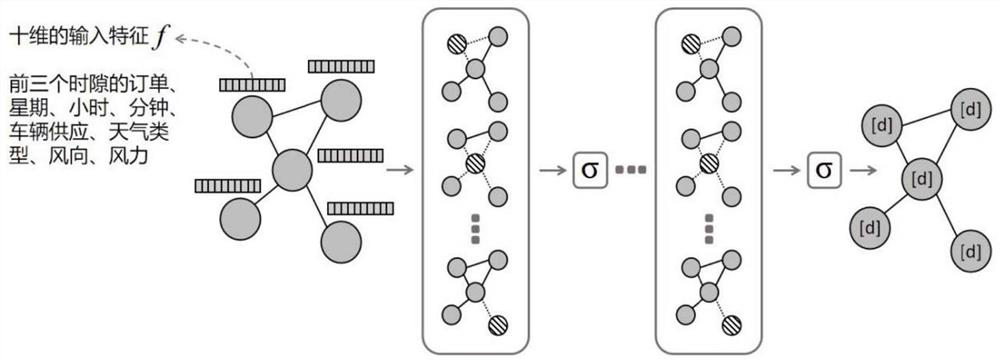Taxi scheduling method and system based on deep reinforcement learning
A technology of reinforcement learning and scheduling methods, applied in the field of artificial intelligence, can solve problems that are not interpretable, cannot reflect the impact of historical decisions, and do not consider the road network structure.
- Summary
- Abstract
- Description
- Claims
- Application Information
AI Technical Summary
Problems solved by technology
Method used
Image
Examples
Embodiment 1
[0096] This embodiment provides a taxi scheduling method based on deep reinforcement learning, such as figure 1 As shown, the method includes the following steps:
[0097] Step 1: Formulate the road network of the selected area into a directed graph G(V,E), where each vertex v∈V represents a geographic location, that is, a road intersection, each edge e∈E represents a road segment, and each Side e obtains the travel cost by calculating cost(e) as the weight of side e.
[0098] Step 2: Apply a region clustering algorithm to pass the graph G through the classified vertices v, thereby forming a specified number of distinct regions Z i .
[0099] Such as figure 2 As shown, the clustering method of the construction region specifically includes:
[0100] First, the road network of the selected city is modeled as a directed graph G(V,E), where each vertex v∈V represents a geographic location, that is, a road intersection, each edge e∈E represents a road segment, and each Side e...
Embodiment 2
[0135] This embodiment provides a taxi dispatching system based on deep reinforcement learning, such as Figure 4 As shown, the system includes: an area building module, a demand forecasting module, a vehicle scheduling module, and a simulator;
[0136] Regional building blocks are used to build regional networks;
[0137] The demand forecasting module predicts the number of orders that will appear in any region at any time according to the regional network;
[0138] The vehicle dispatching module is responsible for the dispatching of vehicles and the training and updating of the taxi dispatching model;
[0139] The simulator simulates the external environment and trains the reinforcement deep learning algorithm based on the actual situation, as well as models the entire process of how the ride-hailing platform manages taxis and handles ride requests.
[0140] The vehicle scheduling module specifically implements the following functions:
[0141] (1) Context state:
[0142...
PUM
 Login to View More
Login to View More Abstract
Description
Claims
Application Information
 Login to View More
Login to View More - R&D
- Intellectual Property
- Life Sciences
- Materials
- Tech Scout
- Unparalleled Data Quality
- Higher Quality Content
- 60% Fewer Hallucinations
Browse by: Latest US Patents, China's latest patents, Technical Efficacy Thesaurus, Application Domain, Technology Topic, Popular Technical Reports.
© 2025 PatSnap. All rights reserved.Legal|Privacy policy|Modern Slavery Act Transparency Statement|Sitemap|About US| Contact US: help@patsnap.com



